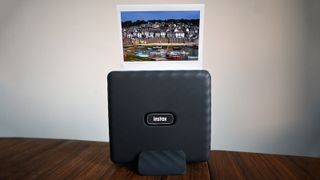TechRadar Verdict
A delightfully simple way to turn your smartphone snaps into analogue photos using Fujifilm's largest instant film format. The Instax Link Wide is a fun alternative to a dedicated instant camera, being far more portable and customisable via its dedicated app. It's our new favorite instant printer.
Pros
- +
Quickly prints vibrant, colorful photos
- +
App gives more control than an instant camera
- +
Large film format has real impact
Cons
- -
Slow battery charging relies on outdated MicroUSB
- -
Instax Wide film quickly gets expensive
- -
More limited film stock than smaller formats
Why you can trust TechRadar
Two-minute review
Film format: Fujifilm Instax Wide
Battery: li-on, rechargeable via microUSB. Approximately 100 shots
Connectivity: Bluetooth
Instax Wide is Fuji's largest instant film format, but you might not know it.
The cameras that use it are big, bulky, and vastly outnumbered by those that take the credit card-sized Instax Mini format. Fuji has also only released one, the Instax Wide 300, since 2015. For a Bluetooth printer like the Instax Link Wide, however, it makes a lot more sense.
The slim, battery-powered printer lets you turn your smartphone snaps into physical prints, either at home or on the move. Paired with Fuji's companion app, you can edit your photos, add filters and generally get creative before you hit print, and you don't have to worry about wasting expensive film like you might with one of the best instant cameras.
With just one button, the Instax Wide is as simple as it gets. The photos it produces are rich, detailed, and because of their sheer size, rather impactful. As they are developed, rather than printed, they have the signature style that makes instant film such a joy to use – although it does mean a minute or two's wait between pressing print and seeing the final result.



It is far less complex than the rival Polaroid Lab, which is more like a desktop darkroom than a printer in the way it 'exposes' each photo using your smartphone's screen, and more authentic than less expensive ZINK printers, which rely on thermally sensitive paper.
Aside from the cost of film, which is among the highest of all instant film formats, the Instax Link Wide has very few weak spots, making it one of the best instant cameras you can buy. Whether you already own an instant camera or not, its blend of smartphone control and physical photos is among the very best around.

Fujifilm Instax Link Wide: Design and Features
- Prints 99x62mm Instax Wide photos
- Compact dimensions
- Ultra-simple operation
The printer itself is basic as it gets, a relatively slimline plastic rectangle with rounded edges and a textured finish that looks rather classy. It's still not small enough to slip into a pocket, but you'll have much less trouble putting it in a bag than you might with the Instax Wide 300 camera.
A simple plastic foot lets you stand it upright on a desk while printing at home, while the wrist strap comes in handy when heading outdoors.
There's just one button on the front face of the printer, which powers it on. A color-changing LED shows when you're printing a photo, and you can customize the hue using the companion app. This app handles all the other functions, and reminds you how many shots you have remaining in your film pack.
Packs are loaded at the rear. Slide the locking latch and the film door springs open, then you insert the pack so that the yellow line on the film lines up with the one on the printer. Close the door and the printer will automatically spit out the pack's protective plastic cover.
Instax Wide film is available as packs of ten shots for roughly £8.50 each (or $18 for 20 exposures). The most common variety has a traditional white border, but Fuji also produces packs with black borders, and you can buy monochrome film as well as color. However, the selection is dwarfed by that of Instax Mini, which can be had in a multitude of frame colors.




Fujifilm Instax Link Wide: Performance
- Intuitive app is quick to pair
- Straightforward software UI
- MicroUSB charging
Pairing the printer with your phone is as easy as powering on the former, and opening the app on the latter. It will automatically search for any nearby Instax printers, and connect with a few taps. You can also pair to a handful of Fuji digital cameras and print directly from them, but the list of compatible models is currently rather small.
The app's main screen contains almost every major function, from simple prints to collages, templates and sketches that use your phone's camera to scan and combine multiple elements. Simple print lets you pick any photo from your camera roll, then zoom, crop, and adjust colours, apply a filter or add text effects before sending it to print. It's all very intuitive, and creative types are sure to love experimenting with their images.
QR codes are a neat extra, letting you add a web shortcut to your pictures that can reveal a location, display a secret message or play back a recorded sound when followed with a smartphone's camera.



Once you're happy, hit the big print button and the finished image will 'fly' up towards the top of your phone, like it's being sent to the printer by tractor beam. Each print takes around 30 seconds to transfer, and another minute or so to develop. You can't connect the printer to a PC or a Mac – it only works via the app, which is available for Android and iOS.
The printer's remaining battery life is always shown at the top of the app's main screen. Fuji claims the Instax Link Wide is good for 100 prints on a full charge, although in our testing it dropped 20% after just ten prints. Charging is done via microUSB, and takes around two hours for a complete top-up.

Fujifilm Instax Link Wide: Image Quality
- Natural colors and contrast
- Impressive level of detail
- Choice of rich or natural color reproduction
Instax film is developed, rather than printed, which creates a signature look that's consistent between sizes. The Instax Link Wide's photos are similar to Instax Mini in terms of colour, contrast and exposure – only they have more impact because they are twice the size.
The film's 3:2 aspect ratio is a closer match to the typical ratio of a digital camera or smartphone than Polaroid's square crop, meaning you don't need to think so much about how you frame your subject.
Pictures are vibrant, with some hues like blues and greens having more punch than others in the default "Instax-Rich" mode. You can swap this for "Instax-Natural" in the app's settings, which creates a more muted look we typically associate with the early instant film of the 1970s. We preferred the Rich mode, which really helps each print stand out.
Picture clarity is rather impressive, with an impressive level of clarity even in wide landscape shots. Only the brightest images show signs of exposure blowout, and are largely consistent with the digital originals rather than affected by the printing process.
Still, Instax isn't going to be a match for an inkjet photo printer when it comes to overall definition, sharpness, or color accuracy. If you prefer those to the charm of instant film, the Instax Link Wide may not be for you.














Fujifilm Instax Link Wide verdict
For the largest, most colorful instant prints wherever you are, without having to lug around a massive instant camera, the Instax Link Wide ticks all the right boxes. It's simple to use, yet its companion app lets you get surprisingly creative with your shots when you want, and doesn't forget the fun nature of instant film.
A more expansive range of Instax Wide film types would be nice, as would faster charging over USB Type-C, but otherwise there's very little to grumble about here.
If you're simply after physical versions of your digital photos, a dedicated photo printer might make more financial sense – but it won't have the same charm as the Instax Link Wide. It's quite simply the best Instax printer around right now.
Should I buy the Fujifilm Instax Link Wide?

Buy it if...
You want the biggest instant photos
Fuji's Instax film doesn't get any bigger than this, and the square crop of Polaroid's rival format has roughly the same surface area.
You take most of your photos with a phone
Bluetooth connectivity is built for printing straight from your handset. While some Fuji cameras also support it, the Instax Link Wide primarily has smartphones in mind
Convenience is king
The easy-to-use smartphone app and built-in battery basically let you take this printer with you everywhere.
Don't buy it if...
You just want to print photos
A dedicated photo printer will be cheaper to run in the long-term, and most are capable of producing much larger prints.
You think instant photography should be about spontaneity
As every photo starts as a digital image, you only need to print the pics you like, which some might say goes against the ethos of instant film
Value for money is most important
Instax Wide film is the most expensive of all of Fuji's instant film formats. The smaller Instax Link Mini is cheaper - albeit with much smaller prints
